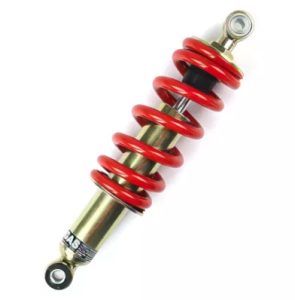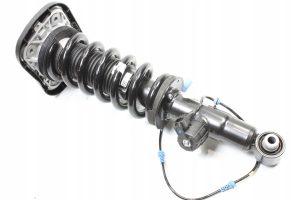Shock absorbers are one of the most essential components of your vehicle’s suspension system. They don’t just smooth out the bumps in the road — they play a key role in handling, braking, tire wear, and overall driving safety. But not all shock absorbers are created equal.
This article compares three main types of shock absorbers — hydraulic (oil), gas, and adaptive (electronic) — to help you understand their differences, advantages, and ideal applications.
What Do Shock Absorbers Do?
Shock absorbers, also known as dampers, control unwanted spring motion. They convert kinetic energy from the suspension movement into heat, which is dissipated through hydraulic fluid. Without them, your car would bounce excessively, become unstable, and lose traction — especially on uneven terrain or during sudden maneuvers.
Main Types of Shock Absorbers
There are three widely used types of shock absorbers in modern vehicles:
| Type | Damping Medium | Technology Level | Typical Use |
|---|---|---|---|
| Hydraulic (Oil) | Oil | Basic | Older vehicles, economy cars |
| Gas-Charged | Oil + Gas | Intermediate | Modern vehicles, sport suspensions |
| Adaptive (Electronic) | Oil + Electronics | Advanced | Luxury cars, performance vehicles |
1. Hydraulic Shock Absorbers

Hydraulic shock absorbers use oil as the damping medium. As the piston inside the absorber moves, oil is forced through small valves, creating resistance that dampens the suspension movement.
Key Features:
-
Simple construction
-
Lower manufacturing cost
-
Smooth damping for standard driving
Pros:
-
Cost-effective
-
Reliable for average driving conditions
-
Easy to repair or replace
Cons:
-
May fade under heavy use
-
Slower response time on uneven surfaces
-
Less suitable for aggressive driving
Best for: Drivers looking for affordable, basic suspension performance.
2. Gas-Charged Shock Absorbers

Gas shock absorbers are similar in design to hydraulic ones but include pressurized nitrogen gas in addition to oil. The gas reduces foaming in the oil, ensuring more consistent damping, especially under high stress or rapid movement.
How They Work:
When the piston moves rapidly, the nitrogen prevents bubbles from forming in the oil (a problem known as cavitation), maintaining consistent performance.
Pros:
-
Better handling than hydraulic shocks
-
More resistant to heat and fading
-
Enhanced ride stability at higher speeds
Cons:
-
Slightly more expensive than hydraulic versions
-
Firmer ride may be less comfortable for some drivers
Best for: Everyday drivers who want a sportier, more responsive suspension feel.
3. Adaptive Shock Absorbers

Adaptive or electronically controlled shock absorbers are the most advanced type available today. They use sensors to monitor driving conditions and adjust the damping force in real time.
Technologies Used:
-
Magnetic Ride Control (Magnetorheological fluid)
-
Electro-hydraulic valves
-
Driving mode selectors (Comfort, Sport, Off-road)
Pros:
-
Offers real-time adjustments
-
Ideal balance of comfort and performance
-
Improves safety and handling in all conditions
Cons:
-
Higher cost
-
More complex system = more expensive repairs
-
Requires electronic control units
Best for: Drivers who value high performance, comfort, and cutting-edge technology — especially in luxury and performance vehicles.
Summary Comparison Table
| Feature | Hydraulic | Gas-Charged | Adaptive |
|---|---|---|---|
| Damping consistency | Medium | High | Very High |
| Ride comfort | High | Medium-High | Adjustable |
| Handling performance | Low | Medium | Very High |
| Cost | Low | Medium | High |
| Best for | Budget vehicles | Daily drivers | Luxury & performance |
How to Choose the Right Shock Absorber
When choosing shock absorbers, consider:
-
Driving style – Do you drive conservatively or aggressively?
-
Road conditions – Are your routes mostly city, highway, or off-road?
-
Vehicle type – Economy car, SUV, truck, or sports car?
-
Budget – Are you looking for affordability or premium performance?
Tip: Always replace shock absorbers in pairs (front or rear) to maintain balance and performance.
Lifespan and Replacement
On average, shock absorbers should be inspected every 50,000–80,000 km, or sooner if you notice:
-
Increased stopping distance
-
Uneven tire wear
-
Nose-diving while braking
-
Excessive bouncing
-
Fluid leaks near wheels
Where to Buy Shock Absorbers?
Looking for quality shock absorbers for your vehicle? Find trusted brands and the right fit for your make and model at this link:
Where to buy Shock Absorbers?
Final Thoughts
Shock absorbers may not be the most glamorous car part, but they are vital to your safety, comfort, and vehicle performance. Understanding the difference between hydraulic, gas, and adaptive shock absorbers helps you make informed choices when it’s time for a replacement or upgrade.
Whether you’re commuting daily, exploring off-road terrain, or fine-tuning a high-performance machine, there’s a shock absorber tailored to your needs.
Take care of your suspension, and your car will take care of you.